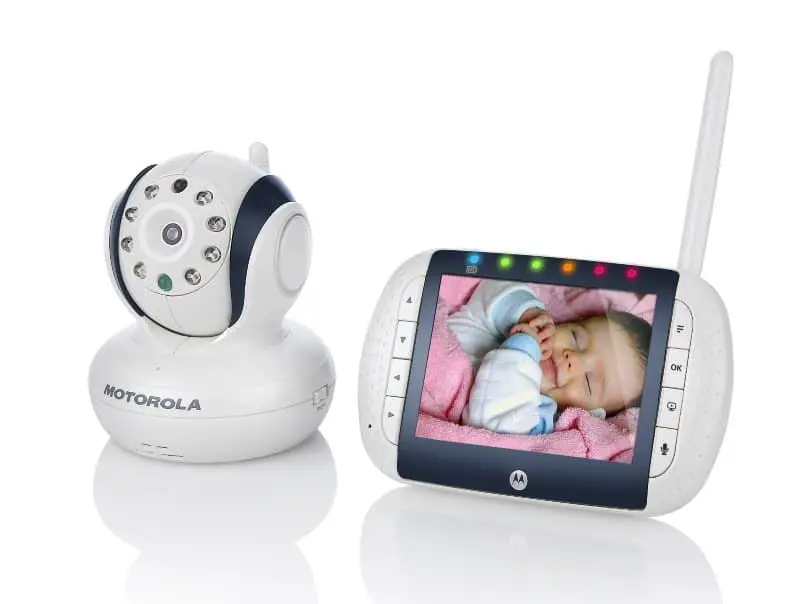Household electronic devices around the home can affect baby monitors. For example, when you connect your mobile device to a broadband network or wireless internet signal it may interfere with the baby monitor. You may hear a clicking, pop or hiss, or even static from the monitor or phone when you turn on the other device.
So, do baby monitors interfere with each other? Baby monitors are installed in a baby’s room to transmit sound and images of the baby. When you want to install more than one baby monitor in a house, you must ask yourself “will these baby monitors interfere with each other?” This article will shed some light on using more than one baby monitor at the same time.
Because of today’s interconnected world, there are various wireless devices that can conflict with the signal band of the baby’s monitor. These devices include: cellular phones, Wifi routers, stereo speakers, and other home appliances.
Baby monitors use a wireless frequency signal band of 2.4 GHz. If this signal comes across another device with similar frequency, it will result in interference. Therefore, a set-up of more than one baby monitor may result in the units interfering with each other. You should ensure there is minimal interference from other electronic devices.
If your baby monitor has a video monitoring feature, it may be affected by poor reception. Sometimes the baby monitor can pick up other conversations from a phone, making it difficult for you to hear sounds from your baby’s room.
Watch this video for the summary, then read the article for the details. I hope you enjoy it!
How do You Know if You are Experiencing Interference?
Whenever there is interference, you may hear a buzzing sound, irritating noise, clicking, popping or a static sound together with the normal audio sound of the monitor.
If you’re using a digital video baby monitor, the video image displayed may look fuzzy, out of focus or have other image issues.
In such cases, you need to know which device is interfering with your baby monitor signal. You may assume your baby monitor is faulty, when actually, it is interference from other devices that is causing it to perform poorly. Is it the extra baby monitor interfering with the first monitor, or is the interference coming from another source in the house?
How do you know which device is affecting the baby monitor?
To determine what is affecting your baby monitor, you will need to be patient and consider all the devices that are in the home and in proximity to the monitor.
Common sense and the process of elimination will go a long way! Ask questions like: Does the interference only happen when the two baby monitors are on at the same time? Is something else impacting both of them or only one of them?
Various devices use the 2.4 GHz band and these devices do not work well in proximity to other wireless devices using the same band.
The most common source of interference with baby monitors is your wireless network and router. This is because they share the same 2.4 GHz band and the routers have a wide range. Also, the baby monitors are on the same band as each other, so having them in close proximity to each other may be causing the interference. Microwaves and stereo speakers are also known sources of interference.
There are various ways you can reduce interference with your baby monitor.
How Can You Reduce Interference?
There are various things you can do to reduce or eliminate wireless interference with your baby monitor. Video monitors use the same frequencies as other wireless devices to send and receive signals. As a result, interference occurs.
To optimize the performance of your baby monitoring devices, you need to understand how a baby monitor functions as well as how the other household wireless devices work in relation to it.
1. Change the monitor channels
A digital baby monitor comes with several channels. This is essential for installing multiple cameras. Most wireless devices use the auto channel as the primary channel to send and receive signals, and the baby monitor is no exception. You can manually change either the baby monitor channel or change the channels of other wireless electronic devices.
Digital baby monitors can use the auto channel function and scan whether there is another device using that channel. If there is, then it switches to the next available channel that has the least amount of interference.
When changing the channels manually, test all the available channels and choose the one that gives you the best performance.
2. Use digital baby monitors
Analog baby monitors are more prone to interference because of their use of radio frequencies. This can be reduced by upgrading to a digital monitor that is encrypted to reduce signal interference. A digital baby monitor reduces static sound and has strong signals.
Analog baby monitor systems have weak signals that can be easily accessed by others through handheld devices like a scanner. The signals do not cover a large distance compared to digital signals.
3. Switch on the baby monitor first
The 2.4 GHz frequency is one of the most commonly used frequencies for video baby monitors. Initially, the 2.4 GHz band was rarely used and as a result, it provided high-level interference-free signals on all wireless devices. Today, almost every wireless device is designed to use 2.4 GHz frequency band thus causing a lot of congestion and interference issues.
You can reduce the impact these wireless devices have on your digital baby video monitor through:
- Switching on the video baby monitor first before switching the other wireless device, it will be the first device to use the 2.4GHz. If you have a broadband router and you keep switching on and off, it will interfere with your video baby monitor.
- Using a cordless phone with a frequency of 900 MHz or 5.8 GHz. When using a 2.4 GHz phone, it will interfere with the baby monitor. As it rings or when using it to browse, it will make the video image appear static. Alternatively, you can minimize interference by putting the phone’s base station and its handset away from the baby monitor’s transmitter and receiver. Maybe this is what you need to reduce interference.
- A wireless network router (Wi-Fi) is another wireless electronic device that affects the 2.4 GHz video baby monitor. If the router has the same 2.4GHz band, it severely affects baby monitor signals and sometimes limits the signal strength or range of the monitor. Whenever a device is connected to the wireless network, it keeps on transferring data from one device to another over the network and this affects the baby monitors’ signals and range. To avoid this, you can connect your devices to a wired LAN router instead of using wireless router. If it’s not possible to use a wired LAN router, always turn off the routers wireless function when not in use.
- If any of these methods don’t minimize interference, you should consider buying a new monitor which uses different frequency band like 900 MHz or 5800 MHz. Click here to read more wireless interference factors that affect baby monitors.
4. Use DECT for audio baby monitors
DECT stands for Digital Enhanced Cordless Communication. It uses a frequency band of 1.9 GHz, and it’s reserved for use by audio digital baby monitor signals. The DECT monitors are expensive compared to other types of baby monitors, but they do not cause any interference, nor are they impacted much by interference from other devices.
5. Use a fully charged batteries
You should always use fully charged batteries in your baby monitors. If the battery is low, then the signals that are sending and receiving will be weak, and may even be dropped. These weakened signals are more prone to interference from the stronger signals around them.
Factors Affecting the Transmission Range of Baby Monitors
The transmission power of a digital baby monitor determines the signal strength and the expected range. Baby monitor signals are affected by a variety of factors. The type of baby monitor also affects the transmission range. Most analog, digital and DECT baby monitors have a range of 50 meters.
Some baby monitors have their own communication technique and have a wider range. Smartphone or Wifi baby monitor transmission range depends on your Wifi signal strength. The following factors can reduce the transmission range of your baby monitor:
1. Concrete Walls
If the house or apartment has thick concrete walls, the walls reduce the transmission range of the baby monitor. Apartments made of stone or concrete reduce the signal range from what is indicated on the monitor box. Therefore, if you’re living in an apartment where the walls are concrete, then the signal range can be disrupted.
2. The degree of insulation in the house
If you live in an insulated house, it can help to reduce heating costs, but it does affect the performance of baby monitors. The transmission range of your baby monitor is impacted by the degree of insulation in the house.
3. Signals around the house
Various electronic devices interfere with each other’s signal, and this has a severe impact on baby monitors. Analog baby monitors are the most affected by these signals from other devices. For example, the signal from the microwave when warming up food can disrupt the baby monitor.
If you’re using a Wifi baby monitor, the transmission range can be affected if additional devices are connected to the Wifi network.
If your neighbors live very close to you, and their baby monitor is using the same channel as your own baby monitor, then you may hear the neighbor’s baby cry through your baby monitor. Similarly, their wireless devices may interfere with your baby monitor, since the signals can pass through walls and ceilings.
Summary
If you want to install multiple baby monitors, or are having issues with the performance of your baby monitor, it is important to understand the role of signal interference.
Baby monitors will interfere with each other if they are set on the same frequency channel. The other reason for interference may be that the monitor is on the same frequency as one of the many modern devices in our lives. If you want to learn more about EMF radiation from a baby monitor, you can check out this article.
Modern wireless devices are designed to use a 2.4 GHz frequency band, and it interferes with your 2.4 GHz video baby monitor. This is the primary cause of issues. The most common sources of interference are wireless routers, microwaves, and stereo speakers. Your neighbors’ wireless devices can also interfere with your audio or video baby monitor. This is because wireless signals can penetrate through walls and ceilings.
There are ways to minimize this interference. For example, you can eliminate interference with some devices by changing the frequency of the other device or the frequency of the baby monitor, so they are not on the same frequency.
If you have two baby monitors, make sure they are on different channels. Many baby monitors are designed with several channels to facilitate the installation of multiple cameras. They also allow you to select the channel with the least interference. You can try several channels to find the one with the least interference.
Sometimes it may be difficult to pinpoint which devices are causing interference with your baby monitoring system if you have a standard 2.4 Ghz unit. The only way you can truly solve this problem is to buy a baby monitor that uses less common frequencies such as 900 MHz and 5800 MHz.


